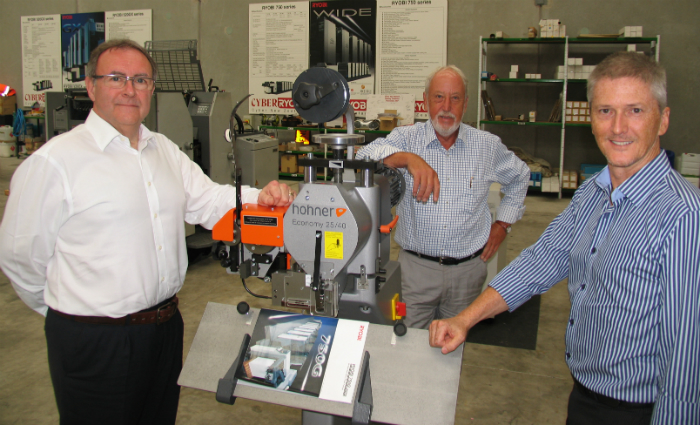|
Recently, John Sykes, managing director of Hohner UK, made a whistle-stop pre-drupa world tour, which included a visit to New Zealand. |
As local distributor for Hohner, Cyber New Zealand hosted Sykes on the Kiwi leg of his tour, where he visited clients and talked about Hohner’s latest finishing machines, which it will run at drupa 2016.
He says, “With drupa coming up, it is good timing to do this trip now. Hohner has some new solutions and I’m hoping they will stay fresh in everyone’s minds when they get to drupa. We will run our solutions in Hall3.”
Among its latest innovations, Hohner will unveil a new saddle stitcher; a redesigned version of the Foldnak Compact Line; and a number of concepts for individual finishing solutions.”
The company has raised its level of excitement over its new HSB 9000 finishing system. Sykes says, “This machine takes you to a different level of build quality. In theory, with the 9000 you can produce up to 9000 books an hour. This machine takes you to a different level of build quality. In fact, the build quality is good enough to use as a trade finisher. We are looking to sell this to a higher end and higher volume printer, remembering that it completes barcoded and variable data.”
“We are aiming this system at printers working in the high-end and high-volume sectors.
Digital and litho
SYKES believes the HSB 9000 finishing system will appeal to printers through its versatility.
He says, “One of the things that makes this machine special is its ability to handle work form digital and litho presses.
An example of this was when we worked with the giant German printer Flyer Alarm, which wanted to produce booklets in a different way. It was producing a car manual and wanted to do a six page booklet that you could open up. It also wanted a glossy cover on 300gms. So it wanted a finishing system that could mix this digital and litho output.
“The HSB 9000 offers, among other things, this system where you can have a feeder; or if you want, you can have hoppers like on a conventional saddle stitcher. One advantage of this system is you don’t have to stop the saddle. That is because you have the one book coming off the saddle. The saddle isn’t waiting for more sections
“You also have up to six fold s on the folder. If you have 900mm sheet length you can finish the work in this way. Obviously if you have a digital press and a litho press, this will give you more flexibility.”
“Also at drupa, we will demonstrate horizontal feeding pockets. That means as we put the sheets in they are stacked horizontally rather than vertically. Visitors will see that there are some advantages with lighter paper to have horizontal figure, although generally, it better to have a vertical feeder.”
Flexibility the key
HE adds that Hohner will work with individual companies to solve issues specific to their requirements. He says, “Any machine make is driven by customer requirement. You have to be flexible. We developed the Flyer Alarm system for higher speeds. We slightly tweaked our machine to take a longer sheet and we don’t have to stop the machine for verification.
“We received another request from a UK company that specialises in keeping college exam papers secure. In this instance, the school has all its exam papers printed in order and each individual exam paper is barcoded. However, each exam paper may need different number of pages. This machine can handle all of those scenarios easily.”
In other cases, the HSB 9000 has seen use for companies printing annual reports but with a portfolio inside. He says, “The portfolio is individualised and printed with digital and the outside is litho printed. The portfolios are all different page lengths.
He says the innovations that Hohner has built into its machines come from applying clients feedback into the design and build process. He says, “We have to be flexible and work with clients. That typifies our approach as a manufacturer. Often, it’s a matter of mixing and matching. For example, speed is important for Flyer Alarm but for other companies, speed is not so important.
“You have to keep your eye on the market rather and stay aware of what people need. We listen, we have constant meetings, and we feedback what people are saying.
Sykes concludes, “We have to be flexible and work with clients. You have to keep your eye on the market rather than say here is my machine, take it or leave it.”


